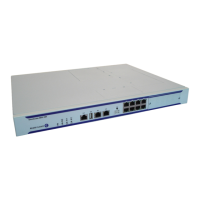Configuring a VPLS Service with CLI
Page 410 7750 SR OS Services Guide
Operationally Forwarding
Configuration BPDUs are sent out a spoke SDP in the forwarding state. Layer 2 frames received
on the spoke SDP are source learned and destination forwarded according to the FIB. Layer 2
frames received on other forwarding interfaces and destined for the spoke SDP are also forwarded.
Spoke SDP BPDU Encapsulation States
IEEE 802.1D (referred as dot1d) and Cisco’s per VLAN Spanning Tree (PVST) BPDU
encapsulations are supported on a per spoke SDP basis. STP is associated with a VPLS service
like PVST is per VLAN. The main difference resides in the Ethernet and LLC framing and a type-
length-value (TLV) field trailing the BPDU.
Table 14 shows differences between dot1D and PVST Ethernet BPDU encapsulations based on the
interface encap-type field:
Table 3: Dot1d and PVST Encapsulation Differences
Field dot1d
encap-type null
dot1d
encap-type dot1q
PVST
encap-type
null
PVST
encap-type dot1q
Destination MAC 01:80:c2:00:00:00 01:80:c2:00:00:00 N/A 01:00:0c:cc:cc:cd
Source MAC Sending Port MAC Sending Port MAC N/A Sending Port MAC
EtherType N/A 0x81 00 N/A 0x81 00
Dot1p and CFI N/A 0xe N/A 0xe
Dot1q N/A VPLS spoke SDP
ID
N/A VPLS spoke SDP encap
value
Length LLC Length LLC Length N/A LLC Length
LLC DSAP SSAP 0x4242 0x4242 N/A 0xaaaa (SNAP)
LLC CNTL 0x03 0x03 N/A 0x03
SNAP OUI N/A N/A N/A 00 00 0c (Cisco OUI)
SNAP PID N/A N/A N/A 01 0b
CONFIG or TCN
BPDU
Standard 802.1d Standard 802.1d N/A Standard 802.1d
TLV: Type & Len N/A N/A N/A 58 00 00 00 02
TLV: VLAN N/A N/A N/A VPLS spoke SDP encap
value
Padding As Required As Required N/A As Required

